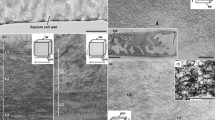Summary
By electron diffraction analysis, highly crystalline cellulose Iβ was found in the house (a special structure in which the tunicate lives) of the appendicularianOikopleura rufescens. Cellulose microfibrils 20 nm in width were observed in a random array or highly organized with rectangular spacing of 2 to 10 (im in the house. The bundled cellulose microfibrils formed in the inlet filters, which are highly ordered meshwork structures. This paper provides the first account of the existence of cellulose in the house of an appendicularian. Our findings showed that the house and tunic are homologous tissues among the tunicates, and that the common ancestor of the tunicates (ascidians, thaliaceans, and appendicularians) already possessed cellulose-biosynthetic ability.
Similar content being viewed by others
References
Alldredge AL (1977) House morphology and mechanisms of feeding in the Oikopleuridae (Tunicata, Appendicularia). J Zool Lond 181:175–188
Belton PS, Tanner SF, Cartier N, Chanzy H (1989) High-resolution solid-state13C nuclear magnetic resonance spectroscopy of tunic in an animal cellulose. Macromolecules 22:1615–1617
Daele VY, Revol JF, Gaill F, Goffinet G (1992) Characterization and supramolecular architecture of the cellulose-protein fibrils in the tunic of the sea peach(Halocynthia papillosa, Ascidiacea, Urochordata). Biol Cell 76: 87–96
Delmer DP (1999) Cellulose biosynthesis: exciting times for a difficult field of study. Annu Rev Plant Physiol Mol Biol 50:245–276
Flood PR, Deibel D (1998) The appendicularian house. In: Bone Q (ed) The biology of pelagic tunicates. Oxford University Press, Oxford, pp 105–124
Hirose E, Kimura S, Itoh T, Nishikawa J (1999) Tunic of pyrosomas, doliolids and salps (Thaliacea, Urochordata): morphology and cellulosic components. Biol Bull 196:113–120
Kimura S, Itoh T (1996) New cellulose synthesizing complexes (terminal complexes) involved in animal cellulose biosynthesis in the tunicate,Metandrocarpa uedai. Protoplasma 194:151–163
Okamoto T, Sugiyama J, Itoh T (1996) Structural diversity of ascidian cellulose. Wood Res 83:27–29
Richmond PA (1991) Occurrence and functions of native cellulose. In: Haigler CH, Weimer PJ (eds) Biosynthesis and biodégradation of cellulose. Marcel Dekker, New York, pp 5–23
Wada H (1998) Evolutionary history of free-swimming and sessile lifestyles in urochordates as deduced from 18S rDNA molecular phylogeny. Mol Biol Evol 15:1189–1194
— Satoh N (1994) Details of the evolutionary history from inverte-brates to vertebrates, as deduced from the sequences of 18SrDNA. Proc Natl Acad Sci USA 91:1801–1804
Author information
Authors and Affiliations
Corresponding author
Rights and permissions
About this article
Cite this article
Kimura, S., Ohshima, C., Hirose, E. et al. Cellulose in the house of the appendicularianOikopleura rufescens . Protoplasma 216, 71–74 (2001). https://doi.org/10.1007/BF02680133
Received:
Accepted:
Issue Date:
DOI: https://doi.org/10.1007/BF02680133




